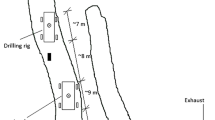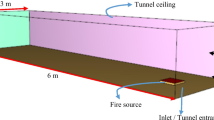Abstract
A series of large-scale fire tests for road tunnel application was conducted in a test tunnel facility in Spain. The aim of this fire tests program was to investigate the magnitude of the heat release rate generated by a fire in heavy goods vehicles (HGV’s) with and without a fire suppression system in tunnels in Singapore; the possibility of interchanging a fire suppression system with other measures such as lowering the longitudinal flow velocity; and to acquire information on the appropriate design parameters (e.g., nozzle type, discharge density and activation time) to adopt based on the most probable fuel load used in these road tunnels. In order to ensure repeatability, simulated HGV’s consisting of 228 pallets with 48 plastic pallets (20%) and 180 wooden pallets (80%) were used in all fire tests. An air velocity of approximately 3 m/s was applied. As the scope of work covered in this fire test program is very large, only the setup of the fire test and the findings on the effects of heat release rate with (Test 4) and without (Test 7) a fixed water based fire-fighting system are covered. The test results indicate that a substantial reduction of fire heat release rate can be obtained using a low-pressure deluge fire suppression system, as long as timely activation of the water is provided. However, the influence of the suppression system on CO production is significant. Such experimental data address the current dearth of knowledge on the actual effect of low-pressure deluge systems on the heat release rate from HGVs in tunnel fires.













Similar content being viewed by others
Abbreviations
- E :
-
Heat of combustion per kmol of consumed oxygen (419.2 MJ/kmol of O2)
- E co :
-
Heat of combustion of CO per kmol of consumed oxygen (563.2 MJ/kmol of O2)
- M :
-
Molecular weight (kg/kmol)
- \( \mathop n\limits^{.} \) :
-
Molar flow rate (kmol/s)
- s:
-
Seconds (s)
- T:
-
Temperature (K)
- Rh:
-
Relative humility (%)
- \( \mathop q\limits^{.} \) :
-
Heat release rate (MW)
- X :
-
Mole fraction (unitless, corresponds to volume fraction for ideal gases)
- e :
-
Exhaust conditions
- d :
-
Dry gas
- i :
-
Incoming air
- CO :
-
Carbon monoxide
- CO 2 :
-
Carbon dioxide
- H 2 O :
-
Water
- N 2 :
-
Nitrogen
- O 2 :
-
Oxygen
- total :
-
Total (e.g. molar flow)
References
Ingason H, Lönnermark A (2005) Heat release rates from heavy goods vehicle trailer fires in tunnels. Fire Saf J 40:646–668
Studiengesellschaft Stahlanwendung e.V Dusseldorf (1995) Fire in transport tunnels—report on full-scale tests, EUREKA-Project EU 499: FIRETUN
Tunnel safety testing (TST) Web-site http://www.tunneltest.com/ingles/tunelensayo.php. Accessed 13 July 2012
Implementation of vehicle immobiliser system in Phase 2 of the Hazmat Transport Vehicle Tracking System, Singapore Civil Defence Force, Jan 2007
Singapore Gazette, Road Traffic Act 2006, Chapter 276, Sections 114 and 140, Road Traffic Expressway Traffic Rules, June 2006
Dlugogorski BZ, Mawhinney JR, Huu Duc V (1994) The measurement of heat release rates by oxygen consumption calorimetry in fires under suppression. Fire Saf Sci 4:877–888. doi:10.3801/IAFSS.FSS.4-877
Parker WJ (1982) Calculation of the heat release rate by oxygen consumption for various applications, U.S. Department of Commerce, National Bureau of Standards, NBSIR 81-2427, 1–38, Feb 1982
Meeussen VJA et al (2008) The effect of a water mist system on large-scale tunnel fires. Proceedings of the ITA COSUF workshop on safety and security of railway and metro tunnels, Graz, Austria, 23 Apr 2008
Acknowledgments
The personnel at Efectis BV, Aquasys and TST are gratefully acknowledged for their work in performing the large-scale tunnel tests at TST tunnel in Spain together with FSSD (Mr Heng Chai Liang, Major Chong Kim Yuan).
Funding
The fire tests were funded by the Land Transport Authority (LTA) in Singapore with the support from the Singapore Civil Defence Force (SCDF).
Author information
Authors and Affiliations
Corresponding author
Rights and permissions
About this article
Cite this article
Cheong, M.K., Cheong, W.O., Leong, K.W. et al. Heat Release Rate of Heavy Goods Vehicle Fire in Tunnels with Fixed Water Based Fire-Fighting System. Fire Technol 50, 249–266 (2014). https://doi.org/10.1007/s10694-013-0367-0
Published:
Issue Date:
DOI: https://doi.org/10.1007/s10694-013-0367-0




